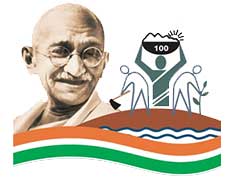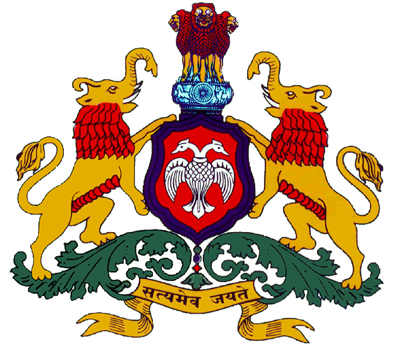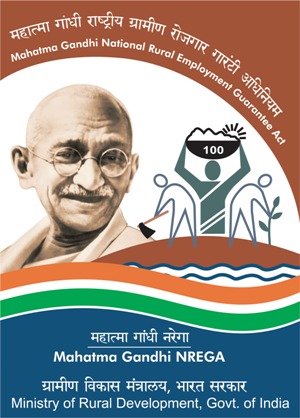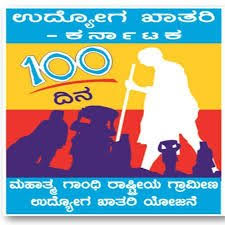
“Jala Sanjeevini”- Reimagining MGNREGA in Karnataka
“Jala Sanjeevini”
Reimagining MGNREGS in Karnataka
‘Scientific Planning of Natural Resource Management works under MGNREGS using Geo-Spatial and Remote Sensing Technologies’
One of the most visible consequences of a warming world is an increase in the intensity and frequency of extreme weather events. Experts say more needs to be done for climate adaption to prevent economic losses, food, and fodder insecurities. Nearly every day in the first nine months of this year, India recorded extreme weather events, including heat waves, cold waves, cyclones, lightning, heavy rainfall, floods, and landslides. Hence it behooves us to bring in elements of sustainability and climate resilience aspects in everything we do and implement, especially so in the Government sector.
The state of Karnataka is one of the most disaster-prone states in southern India due to its geographical diversity. The state is prone to various types of natural disasters. Disaster Management is the new process that has been evolving especially in India over the last decade. The issue of increasing frequency and severity of the disasters requires a more systematic and planned approach in mitigating them. Also, water conservation is an important issue to be addressed from village to national and global levels. Consequently, effective measures are needed to conserve water from the grass root level.

In the light of the above context, Rural Development and Panchayat Raj Department, Government of Karnataka has decided to implement Mahatma Gandhi National Rural Employment scheme (MGNREGS) activities exclusively on watershed-based Ridge to Valley concept approach using Remote Sensing – Geographic Information System (RS-GIS) technology. The Government in collaboration with various Civil Society Organizations (CSO) is implementing Natural Resources Management (NRM) works that are collectively identified (using community participatory approach), falling under Schedule-I, Category-A of MGNREG Act. The main objective of the current aforesaid programme is to increase green cover in villages, community & individual farmers’ lands and forests. Attempt to raise the ground water levels systematically, improve food and nutrition security for rural citizens, reclaiming and rejuvenating the Commons, like water bodies and grazing lands, for water and fodder securities, bring down degradation of land and soils, thereby contributing towards maintaining an ecologically balanced usage of natural resources, using the NRM works under the world’s largest employment guarantee scheme, the Mahatma Gandhi National Rural Employment scheme.
The state of Karnataka has 45.82 lakh active job cards under MGNREGS, comprising 88.59 lakh active workers. The state has completed 2,96,399 NRM works in the year 2021-22, with a total expenditure of Rs 4780.60 Crore, which comes to 71.78% of total MGNREGS expenditure last year.

In Karnataka, the whole concept of scientific based planning of MGNREGA is being materialized and implemented under the tagline “JALA SANJEEVINI”.
“Jala Sanjeevini” is a unique program initiated by Rural Development and Panchayat Raj Department in Karnataka for scientific identification & implementation of MGNREGA activities on watershed-based Ridge to Valley concept using RS & GIS technology.
During the implementation process of MGNREGA works in Gram Panchayat (GP), suitability of the worksites will be identified through geo-spatial technologies, where different thematic maps are used to obtain geographical information and determine the location of the suitable sites.
- Planning tools Used:
In this regard, for the purpose of continuous monitoring and evaluation on scientific basis, the Government in collaboration with various organizations is preparing and implementing the current programme from next three financial years viz., 2023-24, 2024-25 and 2025-26.

- Important Stages of Jala Sanjeevini:
The preliminary step to initiate this process of planning includes collecting the socio- economic profile of a GP, which includes the basic details of village like demography, geographical and economic details. These basic details of a gram panchayat help in calculating the water budget of that GP, while indicating the availability of water in that GP whether deficit or surplus. The GP with deficit water availability must plan for water storage structures in their scientific planning proposal, wherein the GP with surplus water needs to plan for water recharge structures, by which the excess runoff can be infiltrated into the ground, so that the groundwater level can be increased.
The core of Jala Sanjeevini programme lies within the planning of NRM structures into a KML file and locating the individual and community works with respect to lat-long of the particular place. This scientific planning begins with overlaying different thematic layers (drainage, slope, land use & land cover, erosion, lineament etc.,) over the GP revenue map also called the cadastral map.
This will scientifically help in identifying the need of the structure and also the location to implement it and this avoids the unscientific planning and implementation of NRM works.
Further the next process will go on with Participatory Rural Appraisal (PRA) exercises, which includes the transect walk and ground truthing the identified works. All the works that have been identified and located in a KML file, must be included in the draft Detailed Project Report (DPR). This draft DPR should be approved in the Ward Sabha as well as in the Gram Sabha’s. The finally approved DPR works, must be uploaded in the Nregasoft web portal.
These steps will form the baseline for the implementation of the new initiative and helps in reimagining the effectiveness of NRM works being implemented under MGNREGS.
The main objective under the present scientific planning is to prepare Detailed Plan Report (DPR) at each GP level using RS-GIS based technologies while keeping watershed-based concept on focus. This is validated and supplemented by democratic and participatory decision-making with processes like door-to-door demand collection, transect walks, PRA, Ward Sabha’s and Gram Sabha’s at the Panchayat level.


3. Special Areas of focus:
- Water Security Plan.
- Identifying the need of NRM Works, deduplication with existing assets.
- Gomala (Grazing Land) Development sub-plan.
- Disaster Management sub-plan.
- Wildlife Area Management sub-plan.
- Livelihood support activities.
> Water Security Plan:
Preparation of a comprehensive water budget plan using the socio-economic data and systematic analysis of demand and supply positions for a particular village is crucial in understanding the status of water availability. The Water Security plan thus prepared by the GPs will aid in better management of water resources through accounting and allocating water to specific farmers/ households.

> Identifying the need of NRM Works, deduplication with existing assets:
After the planning of NRM structures into a KML file and the PRA exercises, the ground truthing and identification of NRM works is done using the Composite Land Assessment & Restoration Tool (CLART mobile application), while the transect walk is being conducted. This aids the planning of region-specific soil and water conservation measures.

> Gomala Development Sub Plan:
The suitable Gomala (Wasteland) will be identified with the help of Revenue Department. The permissible NRM works such as boundary trenches, bio fencing, planting of forest tree species and grasses for pasture development, construction of boulder checks, diversion channels and gokatte along with boundary plantations etc will not only help in land reclamation and build up the greenery in the barren land but also provides the much-needed fodder for the livestock.
The works of the Gomala development sub plan is captured in the template as given below.


> Disaster Management Sub Plan:
The State has already identified areas which are frequently affected by Drought, Floods and Landslides. Integration of disaster risk reduction & Climate Change adoption into MGNREGS programme is essential. The data obtained from Karnataka State Disaster Management Authority (KSDMA), is utilized to scientifically plan and implement the NRM works.

The works that are suitable for different kind of disasters are as included in the Template as given below.

> Wildlife Area Management sub-plan:
Karnataka has a rich diversity of flora and fauna. Its forest area of constitutes 22% of the total geographical area of the state. It houses a variety of animals and birds. However, expansion of agriculture implementation of development activities like hydel projects, irrigation canals, road and railway network have led to decreased forest area. The animal populations look for alternative sources towards human settlement areas and finally end up in Human Wildlife Conflicts. The Wildlife Sub plan under Jala Sanjeevini is planned with components such as construction of boundary trenches, development of pasture, implementation of various soil and water conservation structures that would aid in mitigating the requirements of food and water for the animals.
> Livelihood support activities:
Overall the implementation of the programme will thrive to achieve higher incomes for the community along with NRM management. Expansion of livelihood options for landless, laborer’s as well as the vulnerable category in the community will be achieved by dovetailing the programme with National Rural livelihood Mission (NRLM) activities being implanted in the State. Construction of animal sheds, horticulture and sericulture activities including raising of plant nurseries will be promoted as permissible under MGNREGS.
4. Planning Tools/Technologies used:
- Bhuvan Portal / Bhuvan Geo-MGNREGA
Bhuvan is a Geoportal of Indian Space Research Organisation (ISRO), hosted through URL https://bhuvan.nrsc.gov.in.
It Provides services and applications related to satellite remote sensing data for public use. Bhuvan Services are offered by NRSC. Striving to realize the Indian Space Vision, is a key player in ISRO’s Earth Observation Programme and Disaster Management Support Programme. NRSC is responsible for the acquisition, processing, supply of aerial and Satellite remote sensing data and for continuously exploring the practical uses of remote sensing Technology for multi-level (global to local) applications.
It is used to collaborate GP Boundary & Thematic maps - Different stream orders in a drainage map, various soil pattern, slope, LULC, Lineament, erosion, Disaster prone areas, watershed maps etc., Bhuvan Geo-MGNREGA portal is used to gather information regarding Existing Geo-tagged Assets, in order to avoid duplication of works & also help in saturation of GPs.
- K-GIS/ KSRSAC (Karnataka State Remote Sensing Application Centre)
Karnataka Geographic Information System (K-GIS - https://kgis.ksrsac.in/kgis/home.aspx) will create GIS based maps and general/common features and provide full services on Remote Sensing and GIS to all the Line Departments. The Line Departments shall consult the KSRSAC before taking up work of updating the GIS data and customization of GIS applications. The nodal agency will work out the planning/architecture of Remote Sensing and GIS implementation / feasibility for new proposals / coding / standardization / training as well as to organize periodic workshops to bring more interaction and co-ordination among the Line Departments”. Since then, the KSRSAC has been coordinating with and providing required GIS information / maps and training to the Line Departments. Various departments data are fetched using this web portal, which will be helpful in order to avoid duplicating works.
Google Earth is a computer program that renders a 3D representation of Earth based primarily on satellite imagery. The program maps the Earth by superimposing satellite images, aerial photography, and GIS data onto a 3D globe, allowing users to see cities and landscapes from various angles. Users can explore the globe by entering addresses and coordinates, or by using a keyboard or mouse. Users may use the program to add their own data using Keyhole Markup Language (KML File) and upload them through various sources, such as forums or blogs. Google Earth is able to show various kinds of images overlaid on the surface of the earth and is also a Web Map Service client.
This program is used to overlay various layers (Drainage, soil, slope, LULC, Lineament etc.,) extracted from Bhuvan/KSRSAC. All NRM structures can be mapped here.
Bhuvan is a Geoportal of Indian Space Research Organisation (ISRO), hosted through URL https://bhuvan-app2.nrsc.gov.in/mgnrega/mgnrega_phase2.php.It Provides services and applications related to satellite remote sensing data for public use. Bhuvan Services are offered by NRSC. Striving to realize the Indian Space Vision, is a key player in ISRO’s Earth Observation Programme and Disaster Management Support Programme. NRSC is responsible for the acquisition, processing, supply of aerial and Satellite remote sensing data and for continuously exploring the practical uses of remote sensing Technology for multi-level (global to local) applications. This portal is used to gather information regarding Existing Geo-tagged Assets, in order to avoid duplication of works & also help in saturation of GPs.
CLART (Composite Land Assessment & Restoration Tool) is a Geographic Information System (GIS) based Android tool developed to enhance the planning of region-specific soil and water conservation measures. CLART enables rural communities in designing measures that would either help recharge of ground water or augment surface water availability, depending upon the location specific geo-hydrological characteristics. Made available in a user-friendly manner for semi-literate village communities, it enables them to undertake major part of the planning and designing, thereby assisting the local government functionaries in speeding the process of approvals, as well as improving the efficacy of ground level implementation.
It is used for ground truthing under MGNREGS for NRM works, after the table-top planning exercise, to understand actual ground reality before implementing the NRM Structures.

- DISHANK Mobile Application
Dishank is an application that can be freely downloaded for Android and iOS devices as well as personal computers. The app will give out information on property details based on records maintained by the Karnataka government.
(https://play.google.com/store/apps/details?id=com.ksrsac.sslr&hl=en_IN&gl=US)
It is used for Survey Analysis - Any works which needs to be taken under Individual beneficiary.
- Experts/NGO’s Involved:
- ANSSIRD&PR, Mysore- Abdul Nazir Sab State Institute of Rural
Development & Panchayat Raj
- KSRSAC - Karnataka State Remote Sensing Application Centre
- KSDMA - Karnataka State Disaster Management Authority
- GIZ - Deutsche Gesellschaft für Internationale Zusammenarbeit
- FES - Foundation for Ecological Security
- AoL - Art of Living
An online SATCOM Programme has also been conducted for enlightening the GP representatives about the initiative. During the demand survey, it has been decided to involve various organizations of village /panchayat level, women SHGs, environmental experts and other Committees working towards Nature Conservation, while preparing the DPR of the GP.
The NRM works in the DPR will be implemented in a phased manner under the Ridge to Valley concept. To implement the program across the state, in collaboration with Abdul Nazir Sab State Institute of Rural Development, GoK and with various organizations, training of all stake-holders, including official (technical and administrative), line departments, elected representatives of all Districts on various topics has been completed at the State, Divisional, District, Block and Gram Panchayat levels.
Extensive IEC for involving the rural community right from visioning, planning, implementing and monitoring Jala Sanjeevini is ongoing.
A Proposed Map including NRM & Non-NRM Activities under Jala Sanjeevini

- Expected Outcomes
- A visible reduction in soil erosion, increase in ground water table, and enhanced green cover over both arable and non-arable lands.
- The GP is capacitated for better management of water resources and regulatory norms for use of water (viz water budgeting) are in place, and are adhered to.
- An increase in productivity levels of various crops and livestock along with enhanced cropping intensity and greater diversification of agricultural production system.
- Alternate livelihood options for all members of the GP ie., farmers, landless agricultural labourers, livestock keepers, artisans etc.
- An increase in average income of all the communities.
- Scientific implementation of works at GP level will serve the purpose of NRM Conservation. Treatment of each watershed will lead to conservation of Soil, Water and Environment, thus providing us with a sustainable future.
- Reducing the negative impact of various disasters on environment.
- Conservation of Wildlife and its habitats and minimising the human- animal conflicts.
***************************************************


MGNREGA Karnataka
Rural Development Commissionerate




































